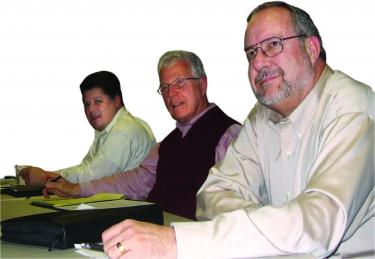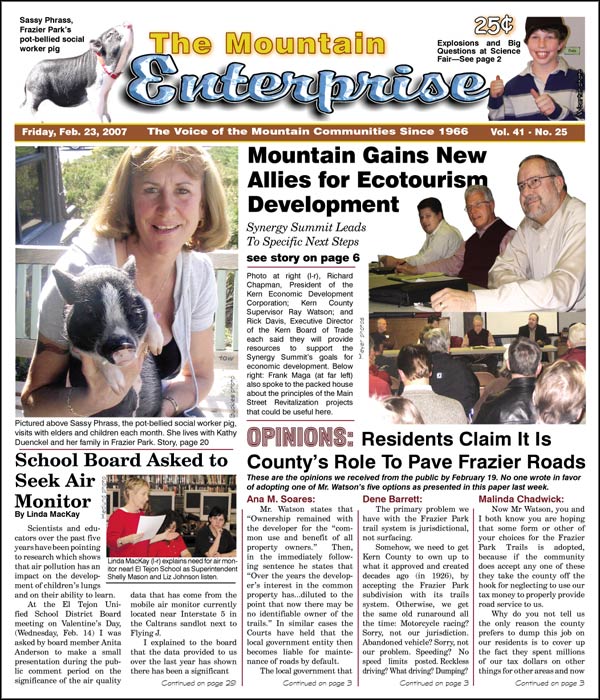
(l-r) Richard Chapman, President of the Kern Economic Development Corporation; Ray Watson, Kern County Supervisor; Rick Davis, Executive Director of the Kern County Board of Trade. Each said they will provide resources to support the Synergy Summit's goals for economic development.
Synergy Summit Leads To Specific Next Steps
By Patric Hedlund
It is a big number: 1.4 million people already come to these mountains each year to play, according to estimates provided at the Synergy Summit II Thursday, Feb. 15 at Cuddy Hall.
About 60 members of the Mountain Communities who are interested in the development of a sustainable ecotourism economy in this area participated.
That 1.4 million number is a rough compilation from statistics gathered by state and federal sources, including the U.S. Forest Service, Hungry Valley OHV Recreational Park and Ft. Tejon State Historic Park.
Local business operators, artists, residents and investors are meeting in the Synergy Summits to explore how to maximize economic development built on keeping the mountains natural. “Castaic is closer than you think,” participant Jan de Leeuw recently wrote, referring to the eruption of proposed developments along the Interstate 5 Grapevine corridor which, if granted permits to grade millions of cubic yards of slopes to build housing, would morph this “Gateway to Kern County” permanently into a continuation of Los Angeles County sprawl.
Rick Davis of the Kern Board of Trade spoke of “Inventory, Infrastructure and Image” as the “three I’s” for setting up an economic development and marketing plan for ecotourism.
Inventory included quick reports from participants regarding the attractions that are already bringing such substantial numbers of visitors.
Fort Tejon’s Sean Malis estimated there are nearly 60,000 visitors annually to the historic Civil War-era site, which is the first U.S. settlement in the mountains. The Fort’s Civil War reenactments draw 2,000 visitors a day.
Kim Matthews and Kathy Saunders of Hungry Valley OHV Park said their visitor figures range between 350,000 to 500,000 depending upon annual weather conditions. They added that $11- 15 billion is brought into the California economy each year through OHV recreation and that the sport has grown by 86% in the past 25 years.
Hungry Valley has nine campgrounds and an abundance of natural and cultural resources. Saunders slides eloquently showed rare poppy fields, woodlands, trails, ancient oaks and wildlife.
District Ranger Tom Kuekes and Recreational Land Use Manager Karen McKinely said the 490,000 acres of the Mt. Pinos District of the Los Padres National Forest serve a broad range of interests, from astronomy to hunting, fishing, hiking, bird watching, off-road recreation, mountain biking, camping, and snow play, bringing about 700,000 visitors annually.
Infrastructure and image enhancements to the Frazier Park area were the focus of comments by Cuddy Valley’s Frank Maga, who spoke of Main Street Revitalization programs around the country. His principals of organization, design, promotion and economic restructuring were quickly taken up by participants and Kern County Supervisor Ray Watson, who discussed the $600,000 beautification and safety project which will be brought to the community in April.
He said that cluster parking plus a more welcoming and walkable main street in Frazier Park are needed.
Richard Chapman of Kern Economic Development Corporation will be providing continued assistance with marketing, and the March issue of The Mountain Pioneer will report in depth on his views. The Mountain Communities Chamber of Commerce, Town Council , and The Mountain Enterprise sponsored the event. Howard Galloway videotaped the conference and Coffee Cantina provided refreshments.
This is part of the February 23, 2007 online edition of The Mountain Enterprise.
Have an opinion on this matter? We'd like to hear from you.


